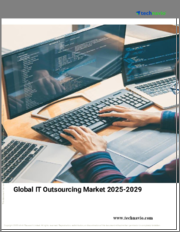
|
시장보고서
상품코드
1597877
통신 아웃소싱 시장 : 유형별, 용도별 - 세계 예측(2025-2030년)Telecom Outsourcing Market by Type (Billing Operations Outsourcing, Call Center Outsourcing, Finance & Accounting Outsourcing), Application (Large Organizations, Small & Medium-Sized Enterprises) - Global Forecast 2025-2030 |
||||||
통신 아웃소싱 시장의 2023년 시장 규모는 1,590억 7,000만 달러, 2024년에는 1,692억 6,000만 달러에 이를 것으로 예측되며, 2030년에는 CAGR 6.89%로 성장해 2,536억 6,000만 달러에 달할 전망입니다.
통신 아웃소싱은 네트워크 관리, 고객 지원, 운영, IT 서비스 등 다양한 통신 서비스 및 기능을 외부 서비스 제공업체에 위탁하는 것을 말합니다. 통신 사업자가 핵심 역량에 집중하고, 비용을 절감하고, 업무 효율성을 높이기 위해 전략적으로 필요한 분야입니다. 응용 분야로는 고객 서비스 센터, 네트워크 유지보수 및 설계, 과금 관리, IT 운영 등이 있습니다. 최종 용도는 무선 통신 사업자, 인터넷 서비스 제공업체, 케이블 서비스 제공업체 등 통신 사업자 전체에 걸쳐 있습니다. 통신 아웃소싱 시장의 성장은 데이터 트래픽 증가, 고속 인터넷 및 무선 연결에 대한 수요 증가, 급속한 기술 발전에 따른 통신사의 인프라 현대화 필요성 등의 요인에 의해 주도되고 있습니다. 또한, 클라우드 컴퓨팅, AI 기반 고객 서비스 솔루션, 5G 기술 통합과 같은 잠재적인 비즈니스 기회가 존재하며, 이는 모두 통신사가 서비스 제공과 고객 경험을 향상시킬 수 있는 길을 제시하고 있습니다. 그러나 데이터 보안에 대한 우려, 아웃소싱 기능에 대한 잠재적 관리 능력 상실, 벤더와의 관계 관리의 복잡성 등이 시장 성장의 제약 요인으로 작용할 수 있습니다. 이러한 제약을 극복하기 위해 통신사업자들은 투명한 파트너십을 구축하고, 강력한 데이터 보안 조치를 취하며, 규제 표준을 준수하는 등 IoT(사물인터넷), 하이브리드 클라우드 솔루션, 안전한 거래를 위한 블록체인과 같은 분야의 혁신이 필요합니다. 블록체인과 같은 분야의 혁신은 경쟁력을 제공하고 비즈니스 성장을 가속할 수 있습니다. 시장 경쟁은 점점 더 치열해지고 디지털 혁신과 지속가능성에 초점을 맞춘 역동적인 시장으로 변모하고 있습니다. 민첩성을 유지하고 선구적인 솔루션 연구 개발에 투자함으로써 기업은 통신 아웃소싱을 효과적으로 활용하고 시장에서의 입지를 확보할 수 있습니다.
| 주요 시장 통계 | |
|---|---|
| 기준 연도(2023년) | 1,590억 7,000만 달러 |
| 예측 연도(2024년) | 1,692억 6,000만 달러 |
| 예측 연도(2030년) | 2,536억 6,000만 달러 |
| CAGR(%) | 6.89% |
시장 역학: 빠르게 진화하는 통신 아웃소싱 시장의 주요 시장 인사이트 공개
통신 아웃소싱 시장은 수요 및 공급의 역동적인 상호작용을 통해 변화하고 있습니다. 이러한 시장 역학의 진화를 이해함으로써 기업은 정보에 입각한 투자 결정, 전략적 의사결정, 새로운 비즈니스 기회를 포착할 수 있습니다. 이러한 트렌드를 종합적으로 파악함으로써 기업은 정치적, 지리적, 기술적, 사회적, 경제적 영역에 걸친 다양한 리스크를 완화하고, 소비자 행동과 그것이 제조 비용 및 구매 동향에 미치는 영향을 보다 명확하게 이해할 수 있습니다.
- 시장 성장 촉진요인
- 차세대 네트워크에 요구되는 관리 요구 증가
- 모바일 가입자 급증
- 기업 및 산업 전반의 클라우드 서비스 도입 확대 및 운영 비용 절감
- 시장 성장 억제요인
- 아웃소싱 사업에 대한 의존으로 인한 불안정성
- 시장 기회
- 5G 구축 및 인프라 확장에 대한 투자
- 통신 분야에서의 스마트 기술 활용
- 시장 과제
- 사이버 보안 및 데이터 유출에 대한 위험성
Portre's Five Forces: 통신 아웃소싱 시장을 탐색하는 전략적 도구
Portre's Five Forces 프레임워크는 시장 상황경쟁 구도를 이해하는 중요한 도구입니다. Portre's Five Forces 프레임워크는 기업의 경쟁력을 평가하고 전략적 기회를 탐색할 수 있는 명확한 방법을 제공합니다. 이 프레임워크는 기업이 시장 내 세력도를 평가하고 신규 사업의 수익성을 판단하는 데 도움이 됩니다. 이러한 통찰력을 통해 기업은 강점을 활용하고 약점을 보완하며 잠재적인 도전을 피함으로써 보다 강력한 시장 포지셔닝을 확보할 수 있습니다.
PESTLE 분석 : 통신 아웃소싱 시장의 외부 영향력 파악
외부 거시 환경 요인은 통신 아웃소싱 시장의 성과 역학을 형성하는 데 매우 중요한 역할을 합니다. 정치적, 경제적, 사회적, 기술적, 법적, 환경적 요인에 대한 분석은 이러한 영향을 탐색하는 데 필요한 정보를 제공하며, PESTLE 요인을 조사함으로써 기업은 잠재적 위험과 기회를 더 잘 이해할 수 있습니다. 이러한 분석을 통해 기업은 규제, 소비자 선호도, 경제 동향의 변화를 예측하고 선제적이고 능동적인 의사결정을 내릴 준비를 할 수 있습니다.
시장 점유율 분석 통신 아웃소싱 시장 경쟁 구도 파악
통신 아웃소싱 시장의 상세한 시장 점유율 분석을 통해 벤더의 성과를 종합적으로 평가할 수 있습니다. 기업은 수익, 고객 기반, 성장률과 같은 주요 지표를 비교하여 경쟁적 위치를 파악할 수 있습니다. 이 분석은 시장의 집중화, 단편화, 통합의 추세를 파악할 수 있으며, 공급업체는 치열한 경쟁 속에서 자신의 입지를 강화할 수 있는 전략적 의사결정을 내리는 데 필요한 통찰력을 얻을 수 있습니다.
FPNV 포지셔닝 매트릭스 통신 아웃소싱 시장에서의 벤더 성과 평가
FPNV 포지셔닝 매트릭스는 통신 아웃소싱 시장에서 벤더를 평가할 수 있는 중요한 도구입니다. 이 매트릭스를 통해 비즈니스 조직은 벤더의 비즈니스 전략과 제품 만족도를 기반으로 평가하여 목표에 부합하는 정보에 입각한 의사결정을 내릴 수 있으며, 4개의 사분면으로 벤더를 명확하고 정확하게 세분화하여 전략 목표에 가장 적합한 파트너와 솔루션을 식별할 수 있습니다. 전략 목표에 가장 적합한 파트너와 솔루션을 식별할 수 있습니다.
통신 아웃소싱 시장에서 성공하기 위한 전략 분석 및 권장 사항
통신 아웃소싱 시장 전략 분석은 세계 시장에서의 입지를 강화하고자 하는 기업에게 필수적입니다. 주요 자원, 역량 및 성과 지표를 검토함으로써 기업은 성장 기회를 식별하고 개선할 수 있습니다. 이러한 접근 방식을 통해 경쟁 환경의 과제를 극복하고 새로운 비즈니스 기회를 활용하여 장기적인 성공을 달성할 수 있도록 준비할 수 있습니다.
이 보고서는 주요 관심 분야를 포괄하는 시장에 대한 종합적인 분석을 제공합니다.
1. 시장 침투도 : 현재 시장 환경의 상세한 검토, 주요 기업의 광범위한 데이터, 시장 도달 범위 및 전반적인 영향력 평가.
2. 시장 개척도: 신흥 시장에서의 성장 기회를 파악하고, 기존 분야의 확장 가능성을 평가하며, 미래 성장을 위한 전략적 로드맵을 제공합니다.
3. 시장 다각화 : 최근 제품 출시, 미개척 지역, 업계의 주요 발전, 시장을 형성하는 전략적 투자를 분석합니다.
4. 경쟁 평가 및 정보 : 경쟁 구도를 철저히 분석하여 시장 점유율, 사업 전략, 제품 포트폴리오, 인증, 규제 당국의 승인, 특허 동향, 주요 기업의 기술 발전 등을 검토합니다.
5. 제품 개발 및 혁신 : 미래 시장 성장을 가속할 것으로 예상되는 첨단 기술, 연구 개발 활동 및 제품 혁신을 강조합니다.
이해관계자들이 충분한 정보를 바탕으로 의사결정을 내릴 수 있도록 다음과 같은 중요한 질문에 대한 답변도 제공합니다.
1. 현재 시장 규모와 향후 성장 전망은?
2. 최고의 투자 기회를 제공하는 제품, 부문, 지역은?
3. 시장을 형성하는 주요 기술 동향과 규제의 영향은?
4. 주요 벤더의 시장 점유율과 경쟁 포지션은?
5.벤더 시장 진입 및 철수 전략의 원동력이 되는 수익원과 전략적 기회는 무엇인가?
목차
제1장 서문
제2장 조사 방법
제3장 주요 요약
제4장 시장 개요
제5장 시장 인사이트
- 시장 역학
- 성장 촉진요인
- 성장 억제요인
- 기회
- 과제
- 시장 세분화 분석
- Porter의 Five Forces 분석
- PESTLE 분석
- 정치
- 경제
- 사회
- 기술
- 법률
- 환경
제6장 통신 아웃소싱 시장 : 유형별
- 청구 업무 아웃소싱
- 콜센터 아웃소싱
- 재무 및 회계 아웃소싱
- 인프라 유지관리 아웃소싱
제7장 통신 아웃소싱 시장 : 용도별
- 대규모 조직
- 중소기업
제8장 아메리카의 통신 아웃소싱 시장
- 아르헨티나
- 브라질
- 캐나다
- 멕시코
- 미국
제9장 아시아태평양의 통신 아웃소싱 시장
- 호주
- 중국
- 인도
- 인도네시아
- 일본
- 말레이시아
- 필리핀
- 싱가포르
- 한국
- 대만
- 태국
- 베트남
제10장 유럽, 중동 및 아프리카의 통신 아웃소싱 시장
- 덴마크
- 이집트
- 핀란드
- 프랑스
- 독일
- 이스라엘
- 이탈리아
- 네덜란드
- 나이지리아
- 노르웨이
- 폴란드
- 카타르
- 러시아
- 사우디아라비아
- 남아프리카공화국
- 스페인
- 스웨덴
- 스위스
- 터키
- 아랍에미리트(UAE)
- 영국
제11장 경쟁 구도
- 시장 점유율 분석, 2023
- FPNV 포지셔닝 매트릭스, 2023
- 경쟁 시나리오 분석
- 전략 분석과 제안
기업 리스트
- Auditel, Inc.
- Cisco Systems Inc.
- Cogneesol
- CustomerServ, Ltd.
- Fujitsu Ltd.
- HCL Technologies Limited
- Hewlett Packard Enterprise Development LP
- Huawei Technologies Co. Ltd.
- IBN Technologies Ltd.
- International Business Machines Corporation
- Motorola Solutions, Inc.
- NEC Corporation
- Nokia Corporation
- Telefonaktiebolaget LM Ericsson
- Wipro Limited
The Telecom Outsourcing Market was valued at USD 159.07 billion in 2023, expected to reach USD 169.26 billion in 2024, and is projected to grow at a CAGR of 6.89%, to USD 253.66 billion by 2030.
Telecom outsourcing entails delegating various telecommunication services and functions, such as network management, customer support, operations, and IT services, to external service providers. It has become a strategic necessity for telecom companies to focus on their core competencies, reduce costs, and enhance operational efficiency. Application areas include customer service centers, network maintenance and design, billing management, and IT operations. The end-use scope spans across telecom companies, including wireless operators, internet service providers, and cable service providers, among others. The growth of the telecom outsourcing market is driven by factors such as increasing data traffic, the rising demand for high-speed internet and wireless connectivity, and the need for telecom companies to modernize their infrastructure amidst rapid technological advancements. Additionally, the market is witnessing potential opportunities in cloud computing, AI-driven customer service solutions, and the integration of 5G technology, all of which present avenues for telecom companies to enhance service delivery and customer experience. However, market growth is challenged by concerns over data security, potential loss of control over outsourced functions, and the complexities involved in managing vendor relationships. To overcome these limitations, telecom companies need to establish transparent partnerships, adopt robust data security measures, and ensure compliance with regulatory standards. Innovation in areas such as IoT (Internet of Things), hybrid cloud solutions, and blockchain for secure transactions can provide a competitive edge and drive business growth. The nature of the market is increasingly competitive and dynamic, with a focus on digital transformation and sustainability, which compel organizations to align their outsourcing strategies with emerging technologies and evolving consumer demands. Remaining agile and investing in R&D for pioneering solutions can enable businesses to leverage telecom outsourcing effectively and secure their position in the market.
| KEY MARKET STATISTICS | |
|---|---|
| Base Year [2023] | USD 159.07 billion |
| Estimated Year [2024] | USD 169.26 billion |
| Forecast Year [2030] | USD 253.66 billion |
| CAGR (%) | 6.89% |
Market Dynamics: Unveiling Key Market Insights in the Rapidly Evolving Telecom Outsourcing Market
The Telecom Outsourcing Market is undergoing transformative changes driven by a dynamic interplay of supply and demand factors. Understanding these evolving market dynamics prepares business organizations to make informed investment decisions, refine strategic decisions, and seize new opportunities. By gaining a comprehensive view of these trends, business organizations can mitigate various risks across political, geographic, technical, social, and economic domains while also gaining a clearer understanding of consumer behavior and its impact on manufacturing costs and purchasing trends.
- Market Drivers
- Increasing need for management required in next-generation networks
- Rapid growth in mobile subscribers
- Rising adoption of cloud services across enterprises and industries and reduction in operating costs
- Market Restraints
- Instability due to dependency on the outsourcing business
- Market Opportunities
- Investments in 5G deployment and infrastructure expansion
- Utilization of smart technologies in the telecom sector
- Market Challenges
- Risks associated with cybersecurity and data loss
Porter's Five Forces: A Strategic Tool for Navigating the Telecom Outsourcing Market
Porter's five forces framework is a critical tool for understanding the competitive landscape of the Telecom Outsourcing Market. It offers business organizations with a clear methodology for evaluating their competitive positioning and exploring strategic opportunities. This framework helps businesses assess the power dynamics within the market and determine the profitability of new ventures. With these insights, business organizations can leverage their strengths, address weaknesses, and avoid potential challenges, ensuring a more resilient market positioning.
PESTLE Analysis: Navigating External Influences in the Telecom Outsourcing Market
External macro-environmental factors play a pivotal role in shaping the performance dynamics of the Telecom Outsourcing Market. Political, Economic, Social, Technological, Legal, and Environmental factors analysis provides the necessary information to navigate these influences. By examining PESTLE factors, businesses can better understand potential risks and opportunities. This analysis enables business organizations to anticipate changes in regulations, consumer preferences, and economic trends, ensuring they are prepared to make proactive, forward-thinking decisions.
Market Share Analysis: Understanding the Competitive Landscape in the Telecom Outsourcing Market
A detailed market share analysis in the Telecom Outsourcing Market provides a comprehensive assessment of vendors' performance. Companies can identify their competitive positioning by comparing key metrics, including revenue, customer base, and growth rates. This analysis highlights market concentration, fragmentation, and trends in consolidation, offering vendors the insights required to make strategic decisions that enhance their position in an increasingly competitive landscape.
FPNV Positioning Matrix: Evaluating Vendors' Performance in the Telecom Outsourcing Market
The Forefront, Pathfinder, Niche, Vital (FPNV) Positioning Matrix is a critical tool for evaluating vendors within the Telecom Outsourcing Market. This matrix enables business organizations to make well-informed decisions that align with their goals by assessing vendors based on their business strategy and product satisfaction. The four quadrants provide a clear and precise segmentation of vendors, helping users identify the right partners and solutions that best fit their strategic objectives.
Strategy Analysis & Recommendation: Charting a Path to Success in the Telecom Outsourcing Market
A strategic analysis of the Telecom Outsourcing Market is essential for businesses looking to strengthen their global market presence. By reviewing key resources, capabilities, and performance indicators, business organizations can identify growth opportunities and work toward improvement. This approach helps businesses navigate challenges in the competitive landscape and ensures they are well-positioned to capitalize on newer opportunities and drive long-term success.
Key Company Profiles
The report delves into recent significant developments in the Telecom Outsourcing Market, highlighting leading vendors and their innovative profiles. These include Auditel, Inc., Cisco Systems Inc., Cogneesol, CustomerServ, Ltd., Fujitsu Ltd., HCL Technologies Limited, Hewlett Packard Enterprise Development LP, Huawei Technologies Co. Ltd., IBN Technologies Ltd., International Business Machines Corporation, Motorola Solutions, Inc., NEC Corporation, Nokia Corporation, Telefonaktiebolaget LM Ericsson, and Wipro Limited.
Market Segmentation & Coverage
This research report categorizes the Telecom Outsourcing Market to forecast the revenues and analyze trends in each of the following sub-markets:
- Based on Type, market is studied across Billing Operations Outsourcing, Call Center Outsourcing, Finance & Accounting Outsourcing, and Infrastructure Maintenance Outsourcing.
- Based on Application, market is studied across Large Organizations and Small & Medium-Sized Enterprises.
- Based on Region, market is studied across Americas, Asia-Pacific, and Europe, Middle East & Africa. The Americas is further studied across Argentina, Brazil, Canada, Mexico, and United States. The United States is further studied across California, Florida, Illinois, New York, Ohio, Pennsylvania, and Texas. The Asia-Pacific is further studied across Australia, China, India, Indonesia, Japan, Malaysia, Philippines, Singapore, South Korea, Taiwan, Thailand, and Vietnam. The Europe, Middle East & Africa is further studied across Denmark, Egypt, Finland, France, Germany, Israel, Italy, Netherlands, Nigeria, Norway, Poland, Qatar, Russia, Saudi Arabia, South Africa, Spain, Sweden, Switzerland, Turkey, United Arab Emirates, and United Kingdom.
The report offers a comprehensive analysis of the market, covering key focus areas:
1. Market Penetration: A detailed review of the current market environment, including extensive data from top industry players, evaluating their market reach and overall influence.
2. Market Development: Identifies growth opportunities in emerging markets and assesses expansion potential in established sectors, providing a strategic roadmap for future growth.
3. Market Diversification: Analyzes recent product launches, untapped geographic regions, major industry advancements, and strategic investments reshaping the market.
4. Competitive Assessment & Intelligence: Provides a thorough analysis of the competitive landscape, examining market share, business strategies, product portfolios, certifications, regulatory approvals, patent trends, and technological advancements of key players.
5. Product Development & Innovation: Highlights cutting-edge technologies, R&D activities, and product innovations expected to drive future market growth.
The report also answers critical questions to aid stakeholders in making informed decisions:
1. What is the current market size, and what is the forecasted growth?
2. Which products, segments, and regions offer the best investment opportunities?
3. What are the key technology trends and regulatory influences shaping the market?
4. How do leading vendors rank in terms of market share and competitive positioning?
5. What revenue sources and strategic opportunities drive vendors' market entry or exit strategies?
Table of Contents
1. Preface
- 1.1. Objectives of the Study
- 1.2. Market Segmentation & Coverage
- 1.3. Years Considered for the Study
- 1.4. Currency & Pricing
- 1.5. Language
- 1.6. Stakeholders
2. Research Methodology
- 2.1. Define: Research Objective
- 2.2. Determine: Research Design
- 2.3. Prepare: Research Instrument
- 2.4. Collect: Data Source
- 2.5. Analyze: Data Interpretation
- 2.6. Formulate: Data Verification
- 2.7. Publish: Research Report
- 2.8. Repeat: Report Update
3. Executive Summary
4. Market Overview
5. Market Insights
- 5.1. Market Dynamics
- 5.1.1. Drivers
- 5.1.1.1. Increasing need for management required in next-generation networks
- 5.1.1.2. Rapid growth in mobile subscribers
- 5.1.1.3. Rising adoption of cloud services across enterprises and industries and reduction in operating costs
- 5.1.2. Restraints
- 5.1.2.1. Instability due to dependency on the outsourcing business
- 5.1.3. Opportunities
- 5.1.3.1. Investments in 5G deployment and infrastructure expansion
- 5.1.3.2. Utilization of smart technologies in the telecom sector
- 5.1.4. Challenges
- 5.1.4.1. Risks associated with cybersecurity and data loss
- 5.1.1. Drivers
- 5.2. Market Segmentation Analysis
- 5.3. Porter's Five Forces Analysis
- 5.3.1. Threat of New Entrants
- 5.3.2. Threat of Substitutes
- 5.3.3. Bargaining Power of Customers
- 5.3.4. Bargaining Power of Suppliers
- 5.3.5. Industry Rivalry
- 5.4. PESTLE Analysis
- 5.4.1. Political
- 5.4.2. Economic
- 5.4.3. Social
- 5.4.4. Technological
- 5.4.5. Legal
- 5.4.6. Environmental
6. Telecom Outsourcing Market, by Type
- 6.1. Introduction
- 6.2. Billing Operations Outsourcing
- 6.3. Call Center Outsourcing
- 6.4. Finance & Accounting Outsourcing
- 6.5. Infrastructure Maintenance Outsourcing
7. Telecom Outsourcing Market, by Application
- 7.1. Introduction
- 7.2. Large Organizations
- 7.3. Small & Medium-Sized Enterprises
8. Americas Telecom Outsourcing Market
- 8.1. Introduction
- 8.2. Argentina
- 8.3. Brazil
- 8.4. Canada
- 8.5. Mexico
- 8.6. United States
9. Asia-Pacific Telecom Outsourcing Market
- 9.1. Introduction
- 9.2. Australia
- 9.3. China
- 9.4. India
- 9.5. Indonesia
- 9.6. Japan
- 9.7. Malaysia
- 9.8. Philippines
- 9.9. Singapore
- 9.10. South Korea
- 9.11. Taiwan
- 9.12. Thailand
- 9.13. Vietnam
10. Europe, Middle East & Africa Telecom Outsourcing Market
- 10.1. Introduction
- 10.2. Denmark
- 10.3. Egypt
- 10.4. Finland
- 10.5. France
- 10.6. Germany
- 10.7. Israel
- 10.8. Italy
- 10.9. Netherlands
- 10.10. Nigeria
- 10.11. Norway
- 10.12. Poland
- 10.13. Qatar
- 10.14. Russia
- 10.15. Saudi Arabia
- 10.16. South Africa
- 10.17. Spain
- 10.18. Sweden
- 10.19. Switzerland
- 10.20. Turkey
- 10.21. United Arab Emirates
- 10.22. United Kingdom
11. Competitive Landscape
- 11.1. Market Share Analysis, 2023
- 11.2. FPNV Positioning Matrix, 2023
- 11.3. Competitive Scenario Analysis
- 11.4. Strategy Analysis & Recommendation
Companies Mentioned
- 1. Auditel, Inc.
- 2. Cisco Systems Inc.
- 3. Cogneesol
- 4. CustomerServ, Ltd.
- 5. Fujitsu Ltd.
- 6. HCL Technologies Limited
- 7. Hewlett Packard Enterprise Development LP
- 8. Huawei Technologies Co. Ltd.
- 9. IBN Technologies Ltd.
- 10. International Business Machines Corporation
- 11. Motorola Solutions, Inc.
- 12. NEC Corporation
- 13. Nokia Corporation
- 14. Telefonaktiebolaget LM Ericsson
- 15. Wipro Limited



















